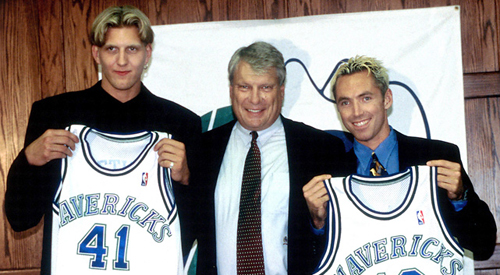
Celebrating the 1998-99 Dallas Mavericks
It’s easier to admit if we say it together: We’re all more familiar with the 2010-11 Dallas Mavericks than we ought to be, from DeShawn Stevenson’s Adam’s apple to Brian Cardinal’s calves. Believe it or not, there once was a time when we were similarly obsessed with the 2005-06 Dallas Mavericks. And the 2005-06 Miami Heat.
What we’ve recently experienced is a temporary obsession, a phenomenon inherent with the increased national exposure that deep NBA playoff runs bring. Easily lost in the chaos of success, however, is the less celebrated past.
Though never forgotten, history is frequently overlook, like back in the summer of 1998 when a Draft Day Mavs trade sent the critically-acclaimed Robert Traylor to the Milwaukee Bucks in exchange for the rights to an unknown Dirk Nowitzki.
Looking back, we smile at the irony, contemplate how different their and our lives would be if things had gone differently and then we move on.
Though Kelly Dwyer does an excellent job of considering such destiny-shifting events (like if, for example, Dirk Nowitzki had gone to Penn State), retroactive speculation theory doesn’t pay the bills – if it did, my commitment to Lost forums 13 months after the series finale would be handsomely rewarded.
Inarguably, truth is truth, just as facts are and will always be facts.
When Nowitzki joined the Mavs in time for the 1998-99 lockout-shortened season, he joined a 20-win ball club. This is a fact. A cold hard one that, unlike the Traylor/Nowizki bulletin, is too depressing for a trivia card. He joined a team that relied heavily on the offensive production of Dennis Scott and Cedric Ceballos the year prior.
[php snippet=1]
The 1997-98 Mavericks were everything from in transition to chronically woeful, but most desperately, they were in need of hope. Unfortunately, the follow up campaign would provide no such immediate salvation, despite the subtle acquisition of the man who would go on to change the fate of the franchise.
Though our 2011-colored glasses numb the pain of the Mavs’ former struggles, the truth of the matter is that the team hadn’t finished better than 10th in the Western Conference in eight years when they dealt for Nowitzki. And their next best rookie was Bruno Sundov. The outlook was bleak.
The perennial misfortune, however, as it often tends to do, made the club and its fan base more resilient – resiliency perhaps necessary for the evolution of the juggernaut contender that flourished over the course of the next decade.
As the theme song of a late-80s, early-90s television series named after a middle-aged woman around whom said show was based once alluded to, what doesn’t kill us, makes us stronger.
In June, 2011 the Mavs were stronger than ever.
In retrospect, the 1998-99 campaign was more than just Nowitzki’s rookie season, it was also Steve Nash’s first as a Maverick. Between the two now-legendary figures, we saw the formation of a friendship, we saw the Don Nelson-inspired fast-paced offense, but most importantly we saw hope (and party photos!).
Knowing what we know now – from Nash’s MVPs to Traylor’s death, from Nowitzki’s ring to Shawn Bardley’s eventual retirement – a look back through the archives of what was once a incessantly underwhelming franchise is almost refreshing. Had it not been for the steadfast commitment of owner Marc Cuban or the continued development of Nowitzki, though, there never would have been a happy ending to the tale that started with Gary Trent averaging 16.0 points per game.
Does a 2011 championship, in Nowitzki’s 13th year as a pro, absolve the franchise for their inability to contend for the better part of a decade? Only Hot Rod Williams and Samaki Walker could say for sure.
What’s most important is that people realize for every mission accomplished – and the overwhelming press that surrounds it – there’s a time when it seemed it would never begin.
[php snippet=1]

